PICK UP
Professional Basics and Techniques
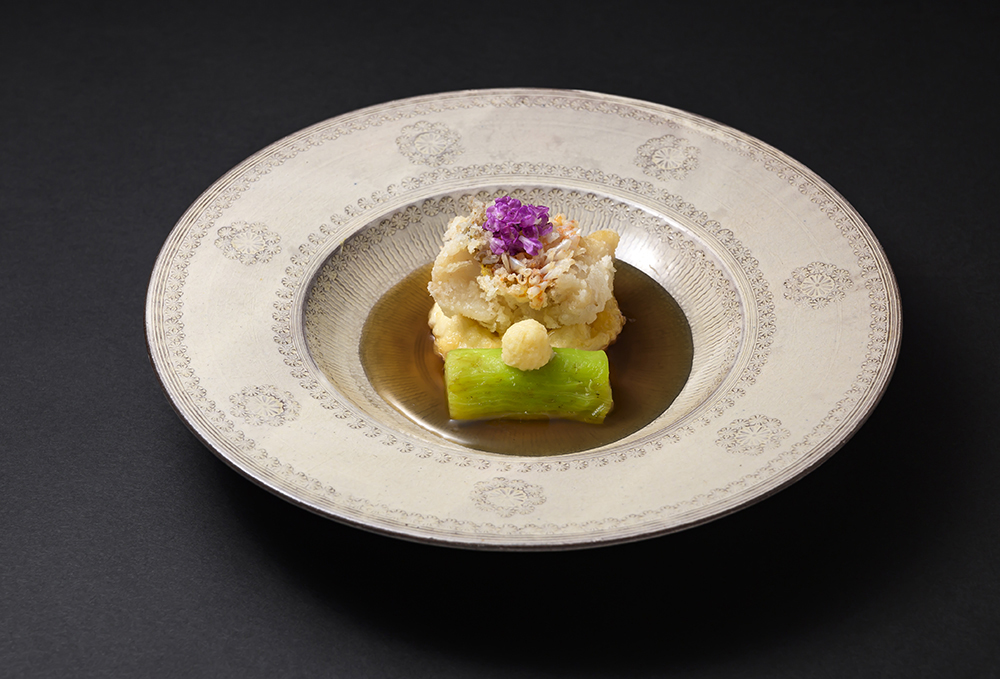
Deep-fried tilefish scales (grilled eggplant, mugwort ginger, deep-fried fresh yuba, shiso flower spikes, delicious bean paste)
今回は、日本料理の中で、「揚物」の基本的な料理について、本多勝彦(銀座 宇 Noki)料理長の提案。料理に於いて、基本的に鱗は取り除いて料理として提供します。今回のような「鱗揚げ」は例外とも言える存在ですが、定番でもあります。生湯葉は茶巾に丸めて形を落ち着かせてから揚げますが、豆乳の風味がしっかり残る上にフワッと柔らかく仕上がるので食感も変わっていて美味しいと思います。鱗揚のカリっとした食感とのメリハリ、コントラストがこの料理のポイントになり、その食感は好評を得ています。
DETAIL
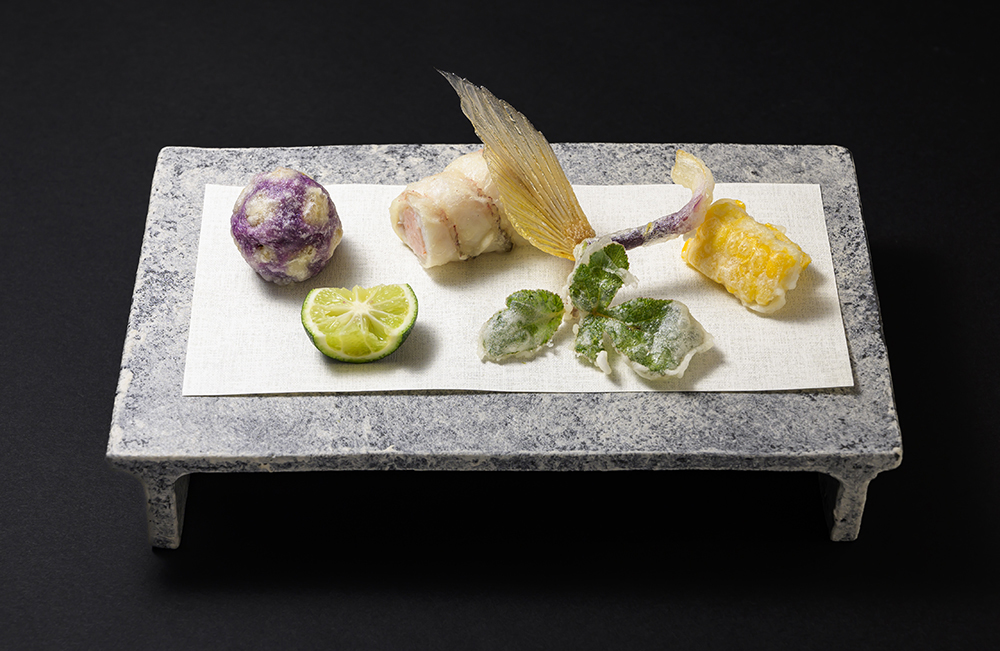
Deep-fried tilefish (with sweet potato buns, corn, Hamabofu, citrus fruit, and sansho pepper salt)
甘鯛の皮目の美しさを活かした手綱揚を紹介します。芯とする部分には車海老で作った海老糝薯とし、甘鯛のうま味に車海老のうま味を重ね合わせて美味しさの相乗効果を狙っています。
芋饅頭は、紫芋とじゃが芋のペーストを丸めた物に、煎って香ばしさを加えた胡桃を食感のアクセントとして入れています。
まったりとした芋の中に胡桃の違った食感と香りが楽しくて面白いかと思います。
DETAIL

White sesame water yokan (fig paste, smooth bean paste, kudzu paste, roasted sesame)
This job is a sweets job that I learned from Yoshiaki Oguma, who has been helping me since I was young. Mizu-yokan has been my favorite since I was in charge of preparation. This time, I used figs, a summer fruit, and finished the flavor to bring out the best in the ingredients, then made the bean paste and poured it over the top.
This time, the theme was sweets using sesame. When you think of mizu yokan, you probably think of something made with red beans, but I wanted it to be something refreshing to eat at the end of a meal, so I made a dish that conveys the rich flavor of sesame. The key is to carefully pour the sesame water.
DETAIL

White sesame blancmange (roasted figs, wild peaches, lotus root crackers, brown sugar syrup)
I made a French dessert called "Blancmange" using sesame and other Japanese ingredients. Traditionally it is made with almond milk, so to get closer to the unique almond flavor, I added the sesame water I made in the professional basic "White Sesame Water Yokan" to add more flavor.
The lotus root crackers served with the blancmange were made using a baking sheet. This time, I used ground lotus root, but depending on the season, you can use various vegetables such as lily bulb, chestnuts, and jiku, which will give a sense of the season and change the flavor. I also garnished it with caramelized figs in a cassonade.
DETAIL

Deep-fried Inaniwa udon noodles with abalone (with grated daikon radish and condiments)
This time, we will be making the basic "meal" "Inaniwa Udon". It is eaten simply with grated daikon radish and condiments, but the temperature and time when making the soup stock are important. If you put kelp in water and heat it for more than 30 minutes, it will become slimy and the soup stock will become cloudy, and if you put shaved Bonito flakes flakes in it for more than 10 seconds, the flavor will become heavy, so be careful.
When making the dashi with Bonito flakes and kelp, the alcohol in the mirin is thoroughly evaporated. This makes the dashi a delicious drink that everyone can enjoy. The abalone is removed from its shell, cut into eight slices, and deep-fried in tempura batter. The oil brings out the sweetness of the abalone.
DETAIL

Red Fuji Inaniwa (White Cloud Abalone,tempura scraps , Condiments)
To make it clear that the raccoon dog has transformed into Red Fuji, I scattered fried abalone flakes (tanuki) around the Fuji-shaped udon noodles. This is a dish that I hope will convey my sense of playfulness. I used "Toyama's dried sardines" to make the dashi. Dried sardines have a strong aroma and umami flavor, which enhances the deliciousness of the dashi. Red-core radish is used in salads and wholesale from spring to summer, but I wondered if I could use this color in something, so I made it look like Red Fuji. The refreshing taste does not get in the way of the udon, and goes well with it.
DETAIL

chirashi sushi
This time, we will be looking at a staple of meals: chirashi sushi.
We want to bring out the aroma of vinegar in our sushi rice, so we make the sushi vinegar using rice vinegar (red vinegar), which has a strong aroma.
This time, we added another layer of enjoyment and changed the visual presentation by serving the tuna, sea bream, flounder, horse mackerel, and other fish on separate plates.
DETAIL

Sushi, sushi, suki, suteki, boat entry, boat departure
This dish was invented as a way to devise a meal based on chirashi sushi. Between the sushi rice, fried ingredients such as fried eggs, fried plums, Bottarga, and matcha are placed and pressed into five layers, which are added to give it a beautiful appearance as well as to accentuate the flavor. We proposed a meal that can be eaten with bare hands instead of chopsticks.
Tatami iwashi is used like sushi seaweed, and is wrapped around sushi rice seasoned with sesame soy sauce and your favorite topping seasoned with wasabi soy sauce, and then eaten with your hands.
The sushi rice is made with half butter and half vinegared rice, and the aroma of the melted butter matches well with the vinegared rice, making it enjoyable for people of all ages and nationalities.
DETAIL

Simmered yellowtail, yellowtail liver (with boiled turnip, chrysanthemum flower lotus root, maple leaf carrot, roasted chestnut, green chili pepper, needle ginger, leaf buds)
This time, we learned about "strong dishes" from Master Mochizuki Teruaki (The New Okura).
He came up with dishes that look delicious and catch your interest at first glance.
DETAIL

Salted yellowtail and radish, simmered abalone in oil (maple carrots, fallen leaf mushrooms, green onions, kamoji ginger, matsuba yuzu, and common bean paste)
To make salted yellowtail radish, the yellowtail is heavily salted and left to sit overnight, which draws out excess moisture from the flesh, removes any unpleasant odor, and gives the dish just the right amount of saltiness.
I often use grilled fish stock made from fish bones, and grilling the bones adds a fragrant flavor to the stock, giving it a punchy taste.
DETAIL

Yamayuri pork skirt steak marinated in miso, grilled matsutake mushroom, conger eel rice crackers, rice porridge rice crackers, prawn rice crackers
A strong appetizer is a dish that goes well with alcohol during the course.
This time, I came up with a dish using delicious pork from Kanagawa Prefecture. I marinated skirt steak in miso, but by adding honey to the miso, the sweetness of the honey was not too strong and brought out the umami of the meat.
In addition, mixing the rice porridge rice crackers with pounded shrimp meat adds the umami flavor of shellfish, making it even more delicious to drink.
DETAIL

Yamayuri pork skirt steak (fruit miso grilled)
We add blueberries and white peaches to the miso base to give the pork a refreshing sweetness without it being too heavy.
The side dishes include sour ones such as simmered Koshu pears and "cream white vinegar" made with sour ricotta cheese.
"Cream White Vinegar" is made by straining drained tofu through a habutae sieve, which changes the texture from gritty to smooth, making it much more palatable.
It takes time and effort, but it's important because it adds value.
DETAIL
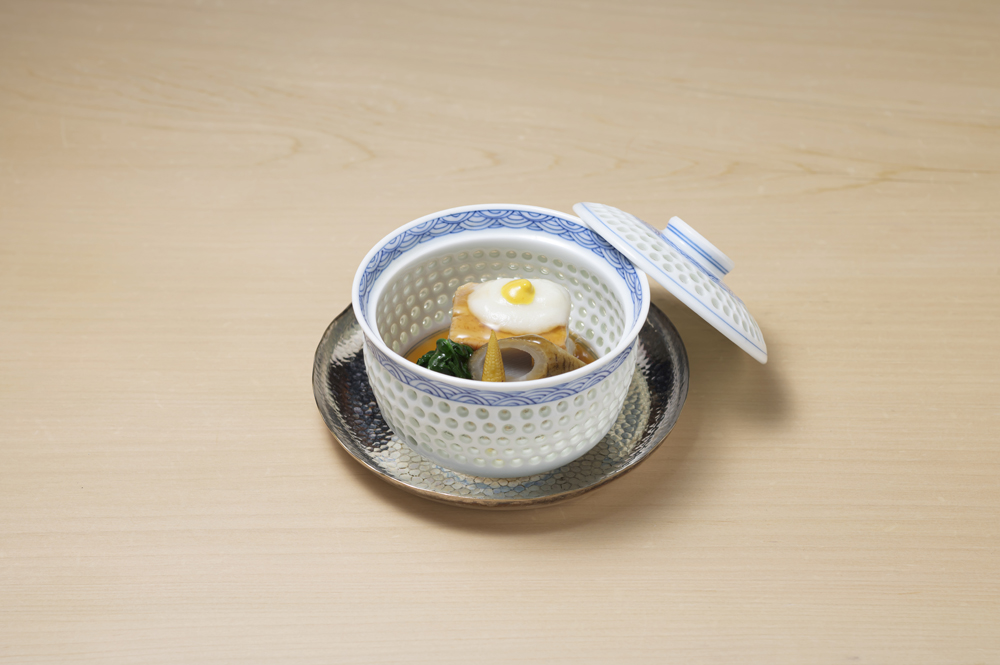
Cooked dish (Kinka pork kakuni, potato bean paste, Newly harvested burdock, iris grass, Japanese mustard)
Jinhua pork is said to be a mythical pork, and is characterized by its unique flavor and richness.
The meat is placed in a steamer as a block and steamed with soybean pulp packed around it. The key point is to steam the meat with a weight on top to prevent it from warping. By doing so, you can drastically reduce the amount of waste that is generated when cutting the meat.
DETAIL
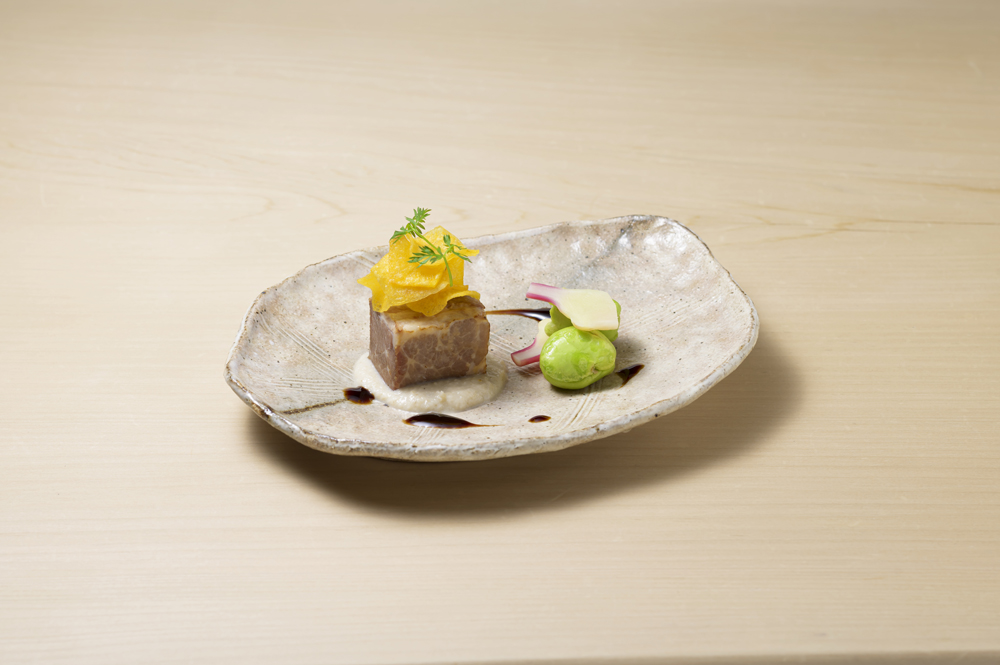
Jinhua pork simmered in oil (with broad beans, vinegared ginger, potato crackers, burdock root, and black vinegar)
Scallion oil is made by slowly heating finely chopped aromatic vegetables in rice oil at low temperature.
Fry for about 15 minutes until the oil is well browned and the fragrant flavor of the aromatic vegetables will be transferred to the oil.
DETAIL

Bowl-style (tiger fish, mugwort tofu, bamboo shoot, myoga ginger, green onion, Japanese sansho pepper)
This time, we asked Shimizu Yuji, head chef of the famous Michelin-starred restaurant Nishiazabu Ichino, to introduce us to "Yogurt tofu," a standard soup topping.
DETAIL

Dried abalone, clams (cut with mugwort kudzu, raw sea urchin), Hamabofu, angelica
I made some mugwort cutlets.
We wondered if we could create something that customers who visit the store multiple times a month would enjoy and not get bored of.
This method can be used for anything from Sakizuke appetizer to a soup dish or a dessert by changing the ingredients and seasonings used inside.
Making it by hand takes time, but it is convenient because you can adjust the thickness and hardness to your liking and cut it into any shape you like. The kudzu in the can is brought together in a hot water bath, but the timing to submerge it in the hot water is when the surface is cooked and the color starts to change.
If you leave it as it is, the surface will become wavy and the finish will not be nice, so quickly submerge it in hot water and cook it all the way through to harden it.
DETAIL

Deep-fried salmon (with tea whisk eggplant, lightly fried chrysanthemum batter, ginger salt, and citrus fruit)
This time, we learned about fried food from Master Toru Sugai (Tokyo Kaikan Mitsubishi Club).
We will cover the basic "Tatsutaage" dish.
DETAIL

Fried salmon (grilled eggplant batter, chrysanthemum flower achara)
In addition to onions and green onions, taro is also added to tawaraage, which makes it more Japanese in appearance.
I highly recommend it as it has a delicious sticky texture.
This time, we used parts that cannot be filleted, such as the backbone and tail meat, and steamed them with a sprinkling of white wine to remove any unpleasant odors and add flavor, then mixed them with taro, onions, and leeks and fried in a tub.
It is eaten with a grilled eggplant batter, which is also found in Turkish cuisine, and it tastes like a refreshing tartar sauce and is delicious.
DETAIL

Fried conger eel with tokusa (fried conger eel with Hachimantai sauce, delicious broth, myoga ginger)
This time, I learned about "agemono" from Master Toru Sugai (Tokyo Kaikan Mitsubishi Club). I will be focusing on "Tokusaage."
DETAIL

Fried sea eel with semolina sauce (fried conger eel with tomato salt and Shiso leaf salt)
The Shiso leaf salt served with the dish is made by removing the moisture from Shiso leaf that are usually left over, baking them in an oven until they become fluffy and crunchy, then mixing them with salt. Shiso leaf has a refreshing aroma that is delicious. If you slice the flounder thinly with a suriko wooden pestle, it becomes deliciously crispy like a rice cracker. The conger eel is steamed in vinegar for about 15 minutes, which not only removes the fishy smell that is particular to conger eel, but also makes the flesh fluffy and soft. This technique can also be used with flounder and scallops.
DETAIL

Ayu fish and female kudzu (new watercress, princess bok choy, shiitake mushroom, yuzu)
This time, I learned about "Owan" from Master Wada Takumi (Japanese cuisine Aogaki). I will be focusing on "Ayuuyojo no Owan".
DETAIL

Broad bean Surinagashi (Pureed soup) (sweetfish, steamed sea urchin, fresh water mustard greens, cherry tomatoes, yuzu)
Broad beans are also called May beans, and are a delicious ingredient in May. I used them this time because of their fresh green color, but other than broad beans, green peas, corn, etc. are also delicious when Surinagashi (Pureed soup) with them. This time, I Surinagashi (Pureed soup) broad beans in a chilled bowl. I used sweetfish as the topping, which I salted and removed the skin before cooking. There is a rich flavor and a bad smell between the skin and the flesh, and the flesh becomes tough when it cools, so I took this process. I think it tastes better if you dilute the dashi with a stronger bonito dashi stock than sweetfish dashi stock.
DETAIL

Sakura Tai Tide Bowl (grilled tofu, shiitake mushrooms, chrysanthemum, green onions, kinome leaf buds)
This time, I learned about "Gowan" from Master Wada Takumi (Japanese cuisine Aogaki). I will focus on "Tsiowan".
DETAIL

Sakuradai wild vegetable roll (ferns, bamboo shoots, butterbur, hook ferns, bell mustard greens, lily root, tree buds)
After wrapping the sea bream with wild vegetables, it is wrapped in peeled daikon radish and steamed. This prevents the skin from shrinking and the flesh from curving. Daikon radish is a vegetable with no particular flavor, so it will not taste good if steamed together with the fish. The moment the lid is opened is important for the soup, so we took the extra step of making Sakuradai Wild Vegetable Roll. Since it is spring, we wrapped it in wild vegetables, but depending on the season, it is also delicious with mushrooms such as king oyster mushrooms or matsutake mushrooms, and it is also delicious when combined with turnips, so please give it a try.
DETAIL

Shiba shrimp minoage (freshly ground oysters, fried dried roots, gongsunju Sweet potato, dried burdock branches, ears of rice, vinegared oranges)
This time, we learned about "agemono" from new master Masaya Tsuji (Wanmiya, Shibadaimon). We will focus on "tsukuage".
DETAIL

Potato bacon minoage (rice cracker fry oysters, taro pine cones, maitake mushrooms and driftwood, yuzu)
Each ingredient is thoroughly seasoned before deep-frying, so it's delicious even when cold, and can also be used as a takeout dish. We tried to create dishes that would leave a lasting impression on customers by using different batters. For the potato bacon minoage, we used five-color noodles to create a colorful dish. For the oyster rice cracker fry dish, we turned the currently popular habanero snack into a powder, allowing customers to enjoy the change in taste and excitement.
DETAIL

Deep-fried spiny lobster yolk (fried matsutake mushrooms, sudachi orange, plain salt)
This time, we learned about "agemono" from new master Masaya Tsuji (Wanmiya). We will focus on "Koromoage".
DETAIL

Shimeji mushroom mushroom noodles with white fan fried noodles, autumn eggplant with fried eggplant yolk (salmon, Chinese yam, Ichimatsu fried eggplant Sweet potato, brown soba Matsuba, Kinzanji miso, tartar sauce, sake Shuto (Salty fermented fish guts), shallots, soy sauce)
When wrapping salmon and Chinese yam in tatami iwashi, lightly steaming the tatami iwashi softens it and makes it easier to roll. Then, to make sure the ingredients are tightly wrapped, it's a good idea to quickly brush the raw iwashi on top. By combining familiar ingredients and taking the extra step, we've created a dish with added value. On top of that, we thought about how the dipping sauce would interest and impact customers. Kinzanji tartar sauce is made with homemade Kinzanji miso with a subdued sweetness, and mustard and mayonnaise have been added. It is popular with customers and can be used in a wide variety of ways.
DETAIL

Butterbur dressed with miso (sea urchin, bamboo shoots, green onions, salted cherry blossoms, roasted sesame seeds)
This time, we learned about "Sakizuke appetizer" from Yoshiaki Masumoto, technical director of the Kanemeguro Branch of the Norinchukin-cho. We will be focusing on "butterbur dressed in miso."
DETAIL
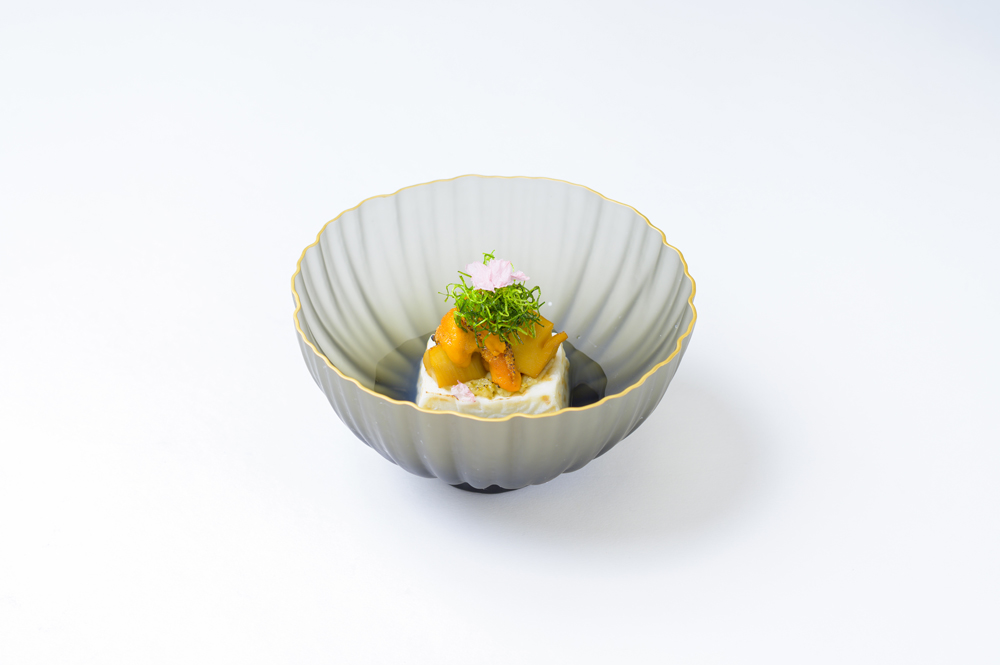
Sesame milk tofu Kintsuba (butterbur miso, fire-cured sea urchin, grilled bamboo shoots, fried green onions, cherry blossom petals)
When making sesame tofu, soaking the sesame seeds in kelp stock overnight before blending them in a blender will help the sesame seeds plump up and bring out their flavor. This will also help the finished product come out beautifully white.
DETAIL

Clear soup (cod milt tofu, snow crab, rock mushroom, thin radish root, kuchi-yuzushi)
This time, we learned about "Gowan" from Master Teiichi Hiratsuka (Kappo Ya Mitsuto). We will be focusing on "cod milt Tofu".
DETAIL

Surinagashi (Pureed soup) cod milt, winter solstice pumpkin shiratama (snow ring radish, 萵薣薹, kuchi-ichimonji yuzu)
The red beans cast into the pumpkin shiratama should be seasoned with a minimum amount of sugar so that the sweetness is not too noticeable. In order to make the most of the flavor of cod milt, it is seasoned with kelp stock and a small amount of seasonings, and is prepared by Surinagashi (Pureed soup). If cod milt roe has a strong odor, adding milk when cod milt it can help reduce the odor.
DETAIL
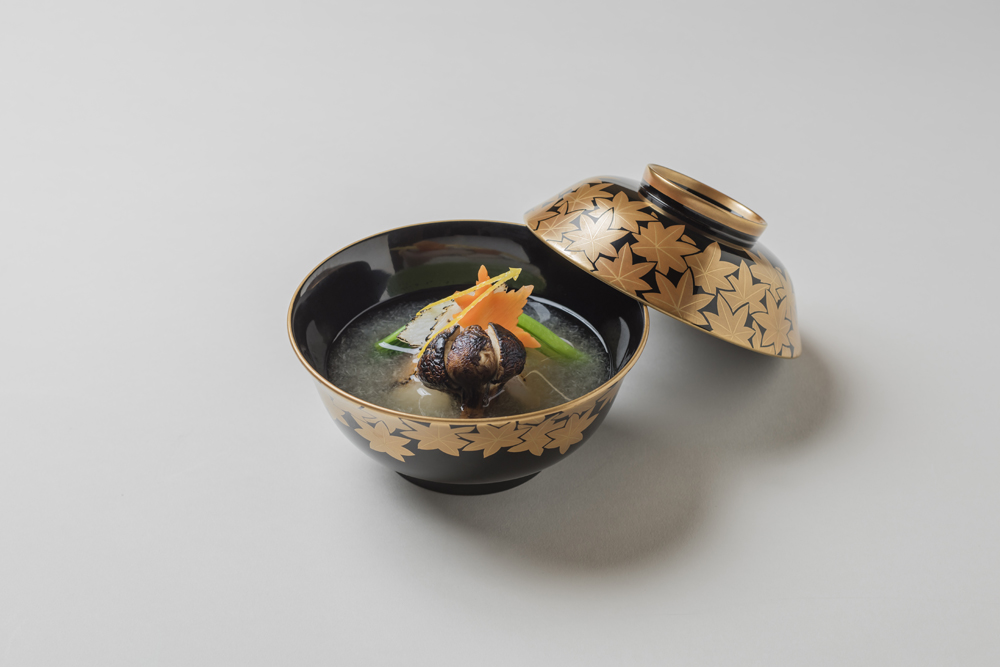
Turnip style (grilled sweet snapper, matsutake mushroom, grilled yam, maple leaf carrot, Edona, matsuba yuzu)
This time, we learned about "Gowan" from Master Teiichi Hiratsuka (Kappoya Mitsuto). We will focus on "Kabushosuri" (a type of sushi rice).
DETAIL
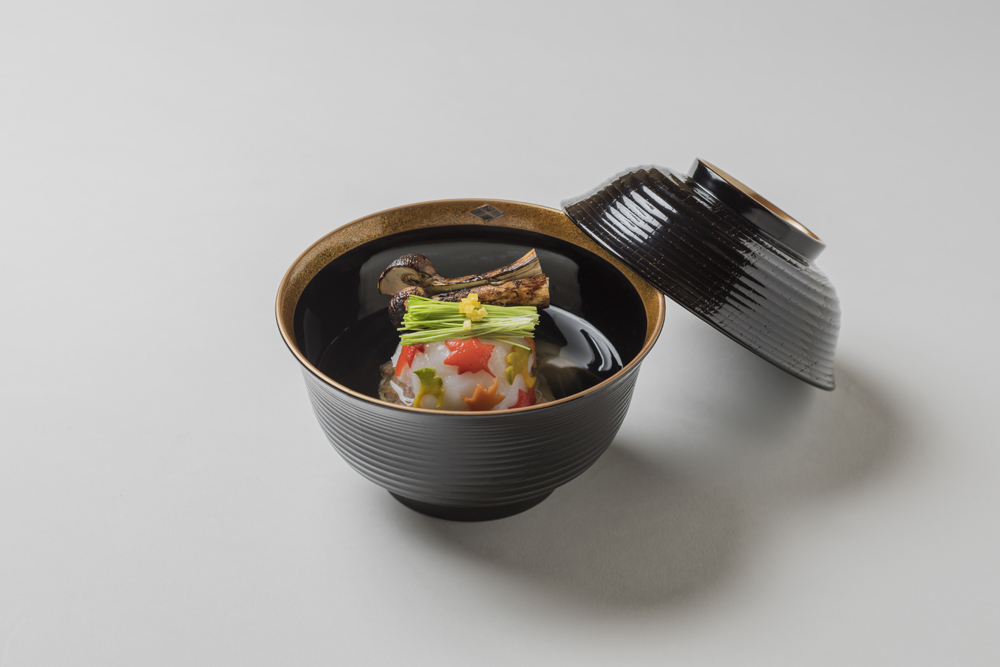
Mixed broth (steamed autumn tilefish with turnip and habutae, matsutake mushroom, green onion, cucumber and yuzu)
When mixing the turnip with the meringue, it is important not to overmix. I think it's best to mix roughly so that it remains fluffy. I thought about how to make steamed turnip efficiently and without much effort. Normally, the steamed turnip falls apart when you cover it with a paste, but by covering it with noshi mochi, it keeps its shape and you can enjoy the unique texture of noshi mochi.
DETAIL

Kamo eggplant assortment (Kamo eggplant, salt-steamed duck, ridged beans, simmered shrimp, thread flower, hajikami)
This time, we learned about pottery from Technical Director Yoshiteru Iwata (Royal Park Hotel). We will focus on Shigi-yaki.
DETAIL

Kamo eggplant grilled somen noodles (Sharan duck style, shrimp crackers, fried green onions, umami powder, foam miso sauce)
Eggplant somen is an ancient craft, but we made it into baked somen to avoid breaking it. If you use normal hot water, the kudzu will fall off, so the key is to put it in water with kudzu to make it smooth. Charan duck is known for its wild and mellow flavor, so we made it Peking duck style to bring out the deliciousness of the fat. Also, since the sauce would have been too heavy if we had used miso on its own, we made a clear layer using only the aroma and salt, adjusted the flavor with soy sauce and red sake, and added sesame seeds to bring out the richness. We used Ina Food Industry's mini drip to mix it together and make it easier to eat.
DETAIL

Grilled sea bass (with Manganji green chili peppers, roasted and marinated, powdered ginger, vinegared myoga pods, and vinegared watercress)
This time, we learned about "yakimono" from Technical Director Yoshiteru Iwata (Royal Park Hotel). We will focus on "aburayaki".
DETAIL

Grilled sea bass with Japanese sansho pepper oil (with rice crackers, Manganji green pepper, vinegared myoga pods, vinegared watercress dressing, deep-fried sansho pepper, sansho pepper oil powder)
We used aromatic oil made from Japanese sansho pepper and rice oil, and cooked it at low temperature to make it fluffy and moist. We use light and healthy rice oil to prevent allergies. To make it light and tasty, we used the currently popular clear soy sauce to make it dressing-like. To thicken it, you can use sticky soybeans, but you can also use baby food thickening agent. We use Maltsec, which can turn fats and oils such as chocolate into various shapes, to turn sansho pepper aromatic oil into powder, which we think is a good way to start a conversation with customers.
DETAIL
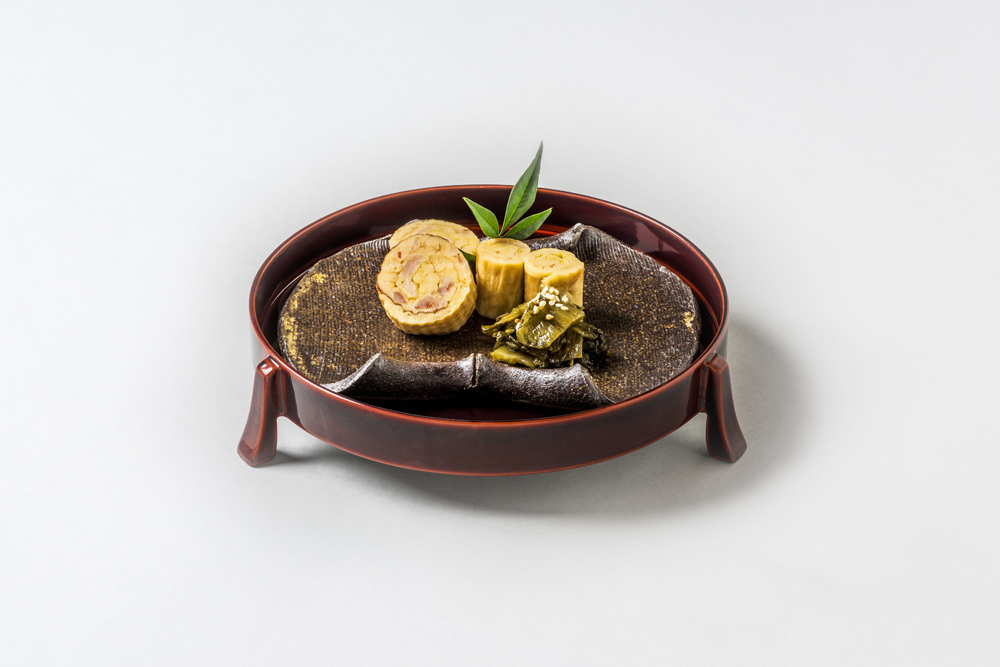
Shrimp Datemaki (Yuzu Datemaki, Stir-fried Takana)
This time, we learned about "potted plants" from Master Isamu Miyata (Hotel New Otani, Kioicho). This time, we will focus on "Datemaki".
DETAIL
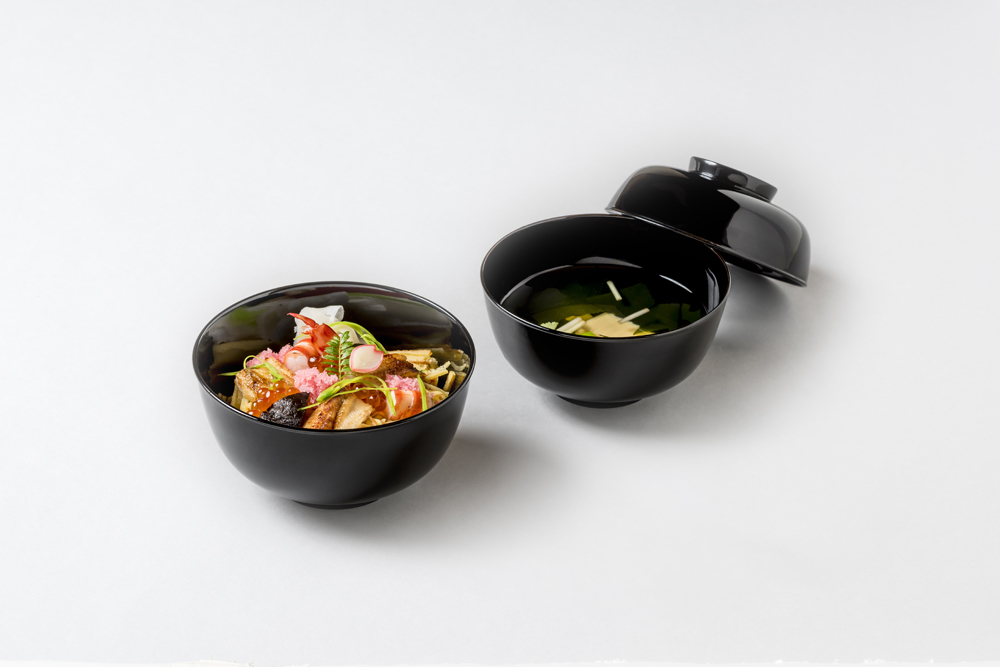
Rose scattered sushi (lily root, shrimp, boiled conger eel, pods, leaf buds, dried gourd, simmered winter mushrooms, lotus root in vinegar, salmon roe)
You can put anything on top of the chirashi sushi, but from a hygienic standpoint, it is better to put something cooked on top. This is a chirashi sushi with various ingredients scattered on top, which makes it stand out for its beautiful colors. Since it is spring, we have served it in a young bamboo bowl.
DETAIL
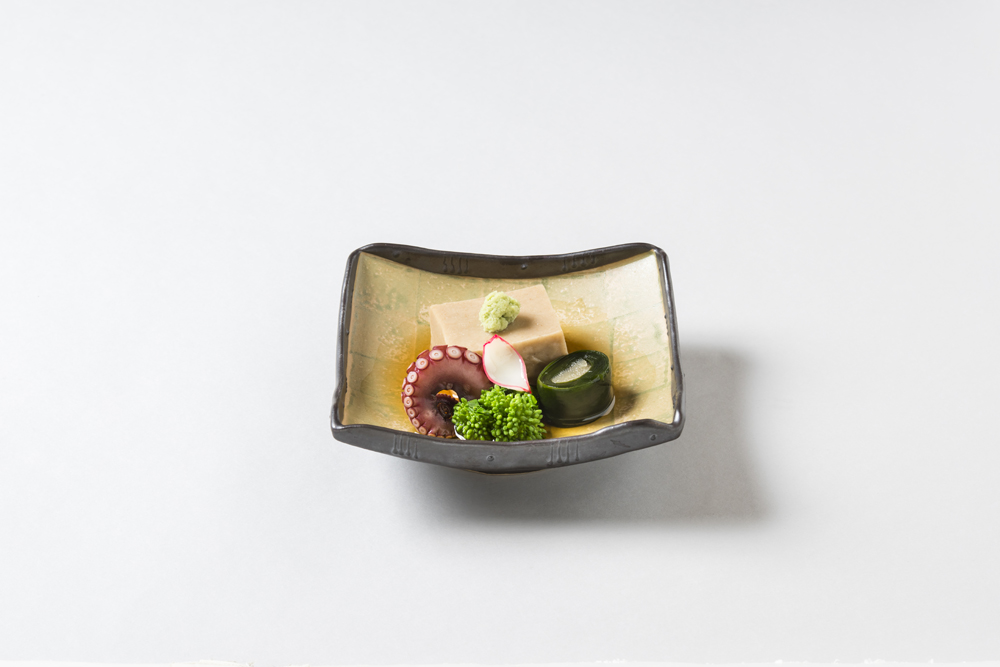
Sesame tofu (rapeseed blossoms, herring roe, smoked octopus, lily petal root, wasabi)
This time, we learned about "potted plants" from Master Isamu Miyata (Hotel New Otani, Kioicho). This time, we will be looking at "sesame tofu".
DETAIL
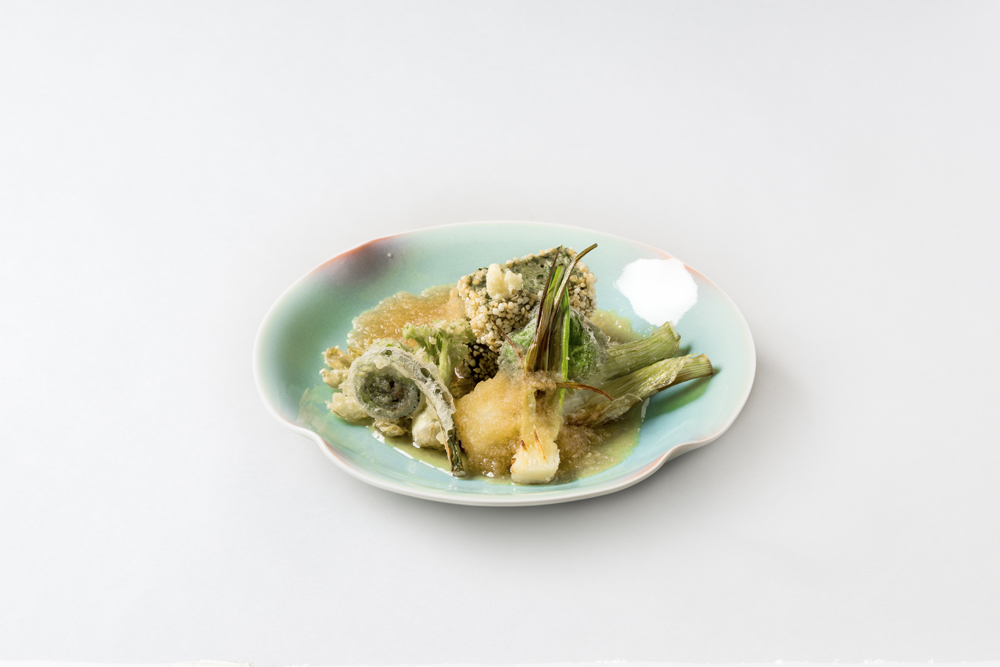
Fried mugwort tofu with brown rice (made with sleet, green onions, Taranome (Japanese angelica bud), kogomi, snowdrops, butterbur shoots, and ginger)
When kneading, we add mugwort, which has moisture, so we knead it even more and pack it in tightly than sesame tofu. Also, because we wanted to serve sesame tofu with wild vegetables, we deep-fry the mugwort tofu with brown rice. Deep-frying brown rice is something we do often at our restaurant, and we've tried a variety of toppings, but I think the umami-rich brown rice is the most delicious.
DETAIL





